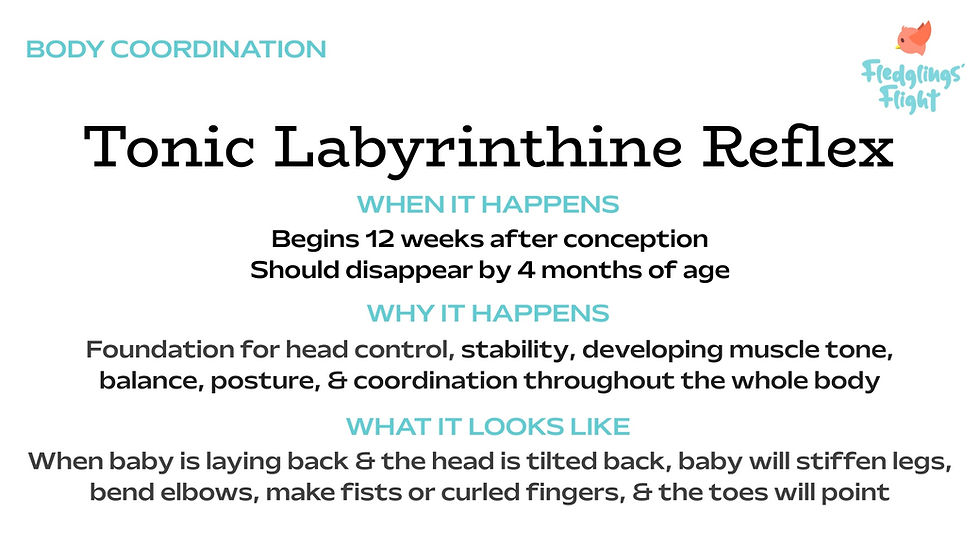Side to Side: How the Spinal Galant Reflex Shapes Movement and Coordination
- Kaylie Estrada
- Sep 16
- 4 min read
Updated: Sep 21
The Spinal Galant Reflex helps your baby with posture.

What are primitive reflexes?
Babies are born with a set of automatic movements called primitive reflexes. These reflexes develop in the womb and help newborns feed, respond to their environment, and build the strength necessary for basic and complex movement. While vital in the first few months, they gradually fade as the nervous system matures, making way for purposeful skills like crawling, standing, and walking.
Each reflex serves a unique purpose. Feeding reflexes, like Sucking and Rooting, allow babies to eat, while self-preservation reflexes such as the Moro help them react to sudden changes. Mobility reflexes, including the Stepping Reflex, Plantar Reflex, and Spinal Galant Reflex, which is today's topic, prepares the body for crawling and walking. In fact, according to the National Library of Medicine, “the Galant and Moro reflexes are among the most critical postnatal primitive reflexes that diminish later in development” [3]. Together, these reflexes help babies adapt to their environment, strengthen their muscles and nervous system, and lay the foundation for future learning and movement.

What is the Spinal Galant Reflex?
The Spinal Galant Reflex can be seen when the outside of the spinal column is stroked, causing their body to curve toward the stimuli. It usually appears at birth and plays an important role in developing trunk coordination and posture. By causing the body respond to touch along the spine, this reflex prepares babies for eventual crawling motions, supports their balance and helps them to understand how their body moves through space.
The Spinal Galant Reflex typically disappears around 9 months of age as voluntary control improves and more advanced motor skills begin to take its place. This reflex usually integrates during vaginal birth as the contractions and muscles of the birth canal help to integrate this reflex. Babies born through Caesarian section have to find alternative ways to integrate the reflex. For this reason, these children tend to show signs of a retained Spinal Galant reflex. The fading of this reflex allows babies to stabilize their posture and transition into controlled crawling and standing.

What happens if the Spinal Galant Reflex Lingers?
When the Spinal Galant Reflex remains active past infancy, it can interfere with focus, posture, and even your child's physical comfort. Children with a retained reflex may fidget constantly or have difficulty sitting still because even slight pressure on their lower back can trigger the retained reflex. Postural issues and challenges with attention in school have also been linked to a lingering Spinal Galant Reflex. Most surprisingly, bedwetting is linked to this reflex as well. Because it plays such a big role in trunk control and body awareness, retention can make sitting upright and still, or coordinating movements harder than expected.

How to test for a retained Spinal Galant Reflex
To check whether the Spinal Galant Reflex is still present, gently stroke along one side of your baby's lower spine. If their hips or body curve strongly toward the side you touched after 9 months of age, this is an indication that the reflex has not fully integrated. If you run two fingers on either side of your baby's spine, they will automatically urinate. During sleep, a child's spine could be stimulated in this way by various things like the sheets or even hair. If your child has a bedwetting problem, it might not be related to mental or physical issues such as a weak bladder. It might just be caused by this retained reflex. This test is easily done at home and can even be done under the guidance of a pediatrician or therapist who can interpret the response and provide you with advice.

What can you do about a retained Spinal Galant Reflex?
If you suspect your child’s Spinal Galant Reflex is still active, start by testing it in infancy just as described previously. Gently stroke one side of your baby’s spine and watch for their response. As children grow older, you may also notice signs like constant wiggling in a chair, difficulty sitting still, or unusual posture. A pediatrician or developmental specialist can check whether the reflex is lingering, and occupational or physical therapists may suggest play-based exercises that build strength and body awareness. Because this reflex is tied to posture and coordination, early support can ease restlessness, improve balance, and make learning and daily activities much easier and more comfortable!
Sources:
Lewis, R. (2020, May 19). What are the primitive reflexes and how are they useful? Healthline. https://www.healthline.com/health/baby/primitive-reflexes?utm
Brain Balance Centers. Retained Primitive Reflexes as a Sign of Brain Imbalance. https://www.brainbalancecenters.com/blog/retained-primitive-reflexes-sign-brain-imbalance
Melillo, Robert, et al. “Retained Primitive Reflexes and Potential for Intervention in Autistic Spectrum Disorders.” Frontiers in Neurology, vol. 13, July 2022, https://doi.org/10.3389/fneur.2022.922322.
Understanding Primitive Reflexes: A Dynamic Perspective on Sensory Motor Development. (n.d.). Sensory Health. https://sensoryhealth.org/node/2060

Want more information like this?
Create a free account with Fledglings' Flight and get access to 4820 screen-free, play-based exercises. That is 100-200 exercises each month that you can start doing with your baby from the day that they are born to help them to develop into the best version of themselves. In addition, your free account gives you access to 1200+ articles on child development to keep you informed while you help to navigate your child's developmental journey.




Comments